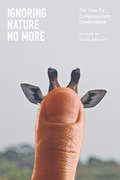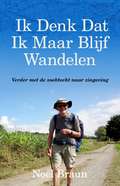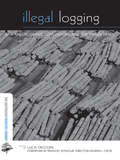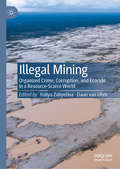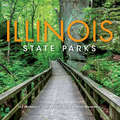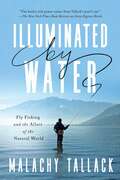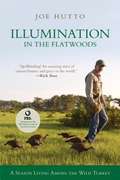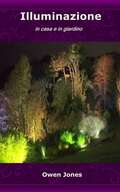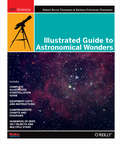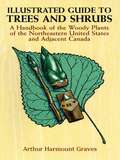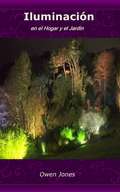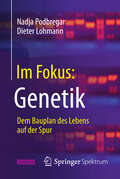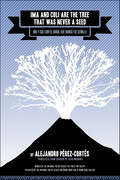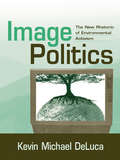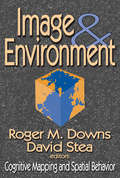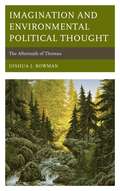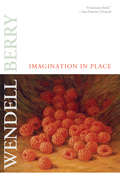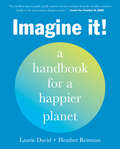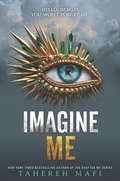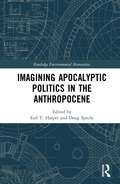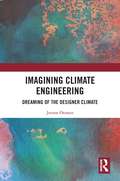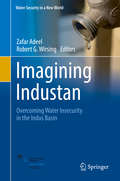- Table View
- List View
Ignoring Nature No More: The Case for Compassionate Conservation
by Marc BekoffFor far too long humans have been ignoring nature. As the most dominant, overproducing, overconsuming, big-brained, big-footed, arrogant, and invasive species ever known, we are wrecking the planet at an unprecedented rate. And while science is important to our understanding of the impact we have on our environment, it alone does not hold the answers to the current crisis, nor does it get people to act. In Ignoring Nature No More, Marc Bekoff and a host of renowned contributors argue that we need a new mind-set about nature, one that centers on empathy, compassion, and being proactive. This collection of diverse essays is the first book devoted to compassionate conservation, a growing global movement that translates discussions and concerns about the well-being of individuals, species, populations, and ecosystems into action. Written by leading scholars in a host of disciplines, including biology, psychology, sociology, social work, economics, political science, and philosophy, as well as by locals doing fieldwork in their own countries, the essays combine the most creative aspects of the current science of animal conservation with analyses of important psychological and sociocultural issues that encourage or vex stewardship. The contributors tackle topics including the costs and benefits of conservation, behavioral biology, media coverage of animal welfare, conservation psychology, and scales of conservation from the local to the global. Taken together, the essays make a strong case for why we must replace our habits of domination and exploitation with compassionate conservation if we are to make the world a better place for nonhuman and human animals alike.
Ignoring Nature No More: The Case for Compassionate Conservation
by Marc BekoffFor far too long humans have been ignoring nature. As the most dominant, overproducing, overconsuming, big-brained, big-footed, arrogant, and invasive species ever known, we are wrecking the planet at an unprecedented rate. And while science is important to our understanding of the impact we have on our environment, it alone does not hold the answers to the current crisis, nor does it get people to act. In Ignoring Nature No More, Marc Bekoff and a host of renowned contributors argue that we need a new mind-set about nature, one that centers on empathy, compassion, and being proactive. This collection of diverse essays is the first book devoted to compassionate conservation, a growing global movement that translates discussions and concerns about the well-being of individuals, species, populations, and ecosystems into action. Written by leading scholars in a host of disciplines, including biology, psychology, sociology, social work, economics, political science, and philosophy, as well as by locals doing fieldwork in their own countries, the essays combine the most creative aspects of the current science of animal conservation with analyses of important psychological and sociocultural issues that encourage or vex stewardship. The contributors tackle topics including the costs and benefits of conservation, behavioral biology, media coverage of animal welfare, conservation psychology, and scales of conservation from the local to the global. Taken together, the essays make a strong case for why we must replace our habits of domination and exploitation with compassionate conservation if we are to make the world a better place for nonhuman and human animals alike.
Ik Denk Dat Ik Maar Blijf Wandelen: Verder met de zoektocht naar zingeving
by Noel BraunEen spirituele ontdekkingsreis langs de Camino de Santiago Sinds Maris, zijn geliefde vrouw waarmee hij 42 jaar was getrouwd, zelfmoord pleegde, worstelde Noel Braun om zichzelf terug te vinden. Hij was al zijn levensovertuigingen kwijt, evenals zijn identiteitsgevoel. In een poging opnieuw houvast te vinden, wilde hij een spirituele tocht maken om zichzelf weer te herontdekken. Hij besloot om de populairste routes van de Camino te wandelen, de oude pelgrimsroutes die door Frankrijk en Spanje naar Santiago de Compostela leiden, in het noordwesten van Spanje. Deze tocht staat beschreven in zijn eerdere boek The Day was Made for Walking. Maar de reis was nog lang niet ten einde. Noel voelde de drang om zijn zoektocht verder voort te zetten. Op 80-jarige leeftijd keerde hij terug naar Frankrijk om een wat minder populaire Camino-route te lopen, die hem ook door Frankrijk naar Spanje voerde. Twee jaar later voelde hij opnieuw de dringende behoefte om door te gaan met wandelen, nu vanuit Portugal naar Spanje. Ondanks zijn vergevorderde leeftijd en zijn vele twijfels, heeft hij genoeg vertrouwen en geloof in zichzelf om de zware inspanningen aan te kunnen en Santiago de Compostela te kunnen bereiken. Fascinerende verhalen over de mensen die hij ontmoet zijn vervlochten met zijn spirituele en emotionele tocht. Ik denk dat ik maar blijf wandelen is het vervolg op het eerste boek. Het fysieke komt met het spirituele samen, evenals geschiedenis met het hedendaagse. Het duikt in de geschiedenis en is tegelijkertijd een persoonlijk verslag en een reisgids.
Illegal Logging: Law Enforcement, Livelihoods and the Timber Trade
by Luca Tacconi'This book carefully blends conceptual insights with extensive empirical evidence to navigate the reader through an issue that is still poorly understood [and is] a valuable reference for the development practitioner to understand the fundamental causes of illegal logging, its myriad consequences and the policy choices available to address the problem' Nalin Kishor, Forest Law Enforcement and Governance Coordinator, The World Bank 'An excellent resource for those working to conserve and sustainably manage forests worldwide. It offers an extensive and comprehensive study of illegal logging, bringing together the knowledge and views of experts who examine its roots and social, economic and environmental implications. One of its important contributions is to show that, unless coupled with reform of forestry regulations to take into account local people, law enforcement to curb illegal logging can negatively impact them. Therefore, any effective and fair approach to the problem needs to involve governments, forestry operators and local communities alike' Gonzalo Oviedo, Senior Social Policy Advisor, IUCN In many countries illegal logging now accounts for a large share of the harvest. Once cut, illegal logs feed an insatiable demand for exotic hardwoods in developed and developing countries. The result has been loss of both revenue and biodiversity, and consequently the issue has risen to the top of the global forest policy agenda as one of the major threats to forests, and donors and national governments are starting to develop initiatives to control illegal logging. Yet for such a massive illegal trade, there is surprisingly limited knowledge available as to the major causes of illegal logging and its impacts on biodiversity, people and livelihoods and national economies, and thus plenty of speculation and action without evidence. It is clear that while illegal logging does have negative impacts, it also, controversially, and perhaps paradoxically, benefits many stakeholders, including local communities. This book, written by the world's foremost experts, examines the key issues including law and enforcement, supply and demand, corruption, forest certification, poverty, local livelihoods, international trade and biodiversity conservation. It includes key case studies from forest-rich hotspots in North, South and Central America, equatorial Africa and Indonesia. While there are clearly no easy answers, this book sorts fact from fiction and explores the many dimensions of the causes, impacts and implications for forests, people, livelihoods and forest policy. Published with CIFOR
Illegal Mining: Organized Crime, Corruption, and Ecocide in a Resource-Scarce World
by Daan Van Uhm Yuliya ZabyelinaThis book provides a comprehensive analysis of the illegal extraction of metals and minerals from the perspectives of organized crime theory, green criminology, anti-corruption studies, and victimology. It includes contributions that focus on organized crime-related offences, such as drug trafficking and trafficking in persons, extortion, corruption and money laundering and sheds light on the serious environmental harms caused by illegal mining. Based on a wide range of case studies from the Amazon rainforest through the Ukrainian flatlands to the desert-like savanna of Central African Republic and Australia’s elevated plateaus, this book offers a unique insight into the illegal mining business and the complex relationship between organized crime, corruption, and ecocide. This is the first book-length publication on illegal extraction, trafficking in mined commodities, and ecocide associated with mining. It will appeal to scholars working on organized crime and green crime, including criminologists, sociologists, anthropologists, and legal scholars. Practitioners and the general public may welcome this comprehensive and timely publication to contemplate on resource-scarcity, security, and crime in a rapidly changing world.
Illinois State Parks
by Lee Mandrell DeeDee Niederhouse-MandrellDiscover the breathtaking beauty and unforgettable adventures that await in Illinois state parks. Lee Mandrell and DeeDee Niederhouse-Mandrell highlight the incredible diversity and natural beauty of the landscapes, flora, and fauna of the state. Marvel at the unique rock formations and 55 foot opening at Cave-In-Rock State Park, or leave the land behind to explore the waterways at Chain O’ Lakes State Park. Step into history at Fort Massac State Park, or sit back and enjoy a striking sunset over the cypress grove at Eldon Hazlet State Park, Illinois’ largest campground. Just in time for the state bicentennial, Illinois State Parks brings together more than 130 gorgeous full-color photographs highlighting some of the most beautiful and popular state parks in Illinois.
Illuminated by Water: Fly Fishing and the Allure of the Natural World
by Malachy TallackIn its blending of nature writing and memoir—also touching on the connection of time, beauty, and memory—Illuminated by Water is an elegiac tribute to fly fishing and the natural world.Illuminated by Water is a book about the author&’s own decades-long passion for fly fishing and how it has shaped the way he sees and thinks about the natural world. That passion is shared and made legible here, not just for other anglers, but for those who have never yet cast a line in the water. Why is it that catching fish—or even thinking about catching fish—can be so thrilling, so captivating? Why is it that time spent beside water can be imprinted so sharply in the memory? Why is it that what seems a simple act of casting a line and hoping can feel so rich in mystery? Alternating between regional and thematic chapters, Tallack considers &‘wildness&’, its pursuit, and its meanings; the compulsive appeal of tying flies; the ethics of catching and killing; the allure of big fish; and beauty—where it&’s sought and where it&’s found. He describes fly fishing trips to America, Canada, Shetland, and England. Throughout the book, certain themes recur—environmental harm and healing; the relationship between fishing and time; hope and its manifestations; and the ways in which angling can deepen engagement with the natural world.
Illumination in the Flatwoods: A Season With the Wild Turkey
by Joe HuttoThe acclaimed account of an astonishing human-turkey relationship. The author describes how he hatched two clutches of wild turkey eggs in an incubator and raised the poults to maturity. Imprinting on him from the moment they hatched, the turkeys fully accepted their human parent into their world. Hutto records their explorations together through fields and woods and the development of their communication and mutual awareness. Along the way he reflects upon the nature of consciousness and the place of humans and animals in the environment.
Illuminazione: in casa e in giardino (Come fare per... #64)
by Owen JonesIlluminazione in casa e in giardino Spero che troverai le informazioni utili, funzionali e redditizie. Le informazioni contenute in questo ebook, su vari aspetti dell'illuminazione domestica per la decorazione e la sicurezza, sono organizzate in 15 capitoli di circa 500-600 parole ciascuno. Spero che susciterà l’interesse di chi desidera aumentare la bellezza e la sicurezza della propria casa. Come bonus aggiuntivo, ti autorizzo a utilizzare il contenuto sul tuo sito web o nei tuoi blog e nelle tue newsletter, anche se è meglio che lo rielabori prima con parole tue. Puoi anche dividere il libro e rivendere gli articoli. In sostanza, l'unico diritto che non hai è quello di rivendere o regalare il libro così come ti è stato consegnato.
Illustrated Guide to Astronomical Wonders: From Novice to Master Observer
by Robert Bruce Thompson Barbara Fritchman ThompsonWith the advent of inexpensive, high-power telescopes priced at under $250, amateur astronomy is now within the reach of anyone, and this is the ideal book to get you started. The Illustrated Guide to Astronomical Wonders offers you a guide to the equipment you need, and shows you how and where to find hundreds of spectacular objects in the deep sky -- double and multiple stars as well as spectacular star clusters, nebulae, and galaxies.You get a solid grounding in the fundamental concepts and terminology of astronomy, and specific advice about choosing, buying, using, and maintaining the equipment required for observing. The Illustrated Guide to Astronomical Wonders is designed to be used in the field under the special red-colored lighting used by astronomers, and includes recommended observing targets for beginners and intermediate observers alike. You get detailed start charts and specific information about the best celestial objects.The objects in this book were chosen to help you meet the requirements for several lists of objects compiled by The Astronomical League.Binocular Messier ClubUrban Observing ClubDeep Sky Binocular ClubDouble Star ClubRASC Finest NGC ListCompleting the list for a particular observing club entitles anyone who is a member of the Astronomical League or RASC to an award, which includes a certificate and, in some cases, a lapel pin.This book is perfect for amateur astronomers, students, teachers, or anyone who is ready to dive into this rewarding hobby. Who knows? You might even find a new object, like amateur astronomer Jay McNeil. On a clear cold night in January 2004, he spotted a previously undiscovered celestial object near Orion, now called McNeil's Nebula. Discover what awaits you in the night sky with the Illustrated Guide to Astronomical Wonders.
Illustrated Guide to Trees and Shrubs: A Handbook of the Woody Plants of the Northeastern United States and Adjacent Canada/Revised Edition
by Arthur Harmount GravesAuthoritative, easily accessible guide omits lengthy technical descriptions in favor of easy-to-use keys covering such characteristics as leaves, twigs, bark, buds, seeds, stems, fruit or fruit stalks, and other identifying traits. Over 300 pen-and-ink drawings by Maud H. Purdy, noted botanical illustrator. "I recommend this book most highly." -- Farida A. Wiley, American Museum of Natural History.
Iluminación en el Hogar y el Jardín (Como hacer... #64)
by Owen JonesIluminación en el hogar y el jardín por Owen Jones Ideas para iluminar el hogar y el jardín Una introducción al uso de la luz para proteger y exhibir de la manera más efectiva su hogar y jardín Iluminación en el hogar y el jardín Espero que la información les resulte útil, interesante y rentable. La información de este libro electrónico sobre diversos aspectos de la iluminación doméstica para la decoración y la seguridad está organizada en 15 capítulos de aproximadamente 500 a 600 palabras cada uno. Espero que sea de útil para aquellos que estén interesados en utilizar este medio económico para aumentar la belleza y la seguridad de su hogar. Como un bono adicional, le concedo permiso para usar el contenido en su propia página web o en sus propios blogs y boletines de noticias, aunque es mejor que los reescriba con sus propias palabras primero. También puede dividir el libro y revender los artículos. De hecho, el único derecho que no tiene es revender o regalar el libro tal como se le entregó.
Im Fokus: Dem Bauplan des Lebens auf der Spur
by Nadja Podbregar Dieter LohmannWelche Macht haben unsere Gene? Sind sie die schicksalhafte Blaupause, die bestimmt, wie intelligent, wie alt oder wie schön wir sind? Lange Zeit war dies die gängige Lehrmeinung. Doch das Dogma ihrer monolithischen Allmacht ist heute längst gefallen. Immer häufiger stoßen Forscher auf Hinweise, wie unser Leben den Genen "ins Handwerk" pfuscht und wie eng die Wechselwirkungen zwischen Erbgut, Stoffwechsel und Umwelt manchmal sind. Die moderne Biotechnologie eröffnet neue Wege der Forschung, wirft aber auch ethische und gesellschaftliche Fragen auf. Dieses Buch erklärt unter anderem, warum bei den Genen die Verpackung manchmal wichtiger ist als der Inhalt, was Viren in unserem Erbgut verloren haben und weshalb es "das Methusalem-Gen" nicht gibt.
Ima and Coli Are the Tree That Was Never a Seed
by Alejandro Pérez-CortésThe new winner of the Paz Prize for Poetry, granted by the National Poetry Series, is the author’s impressionistic homage to his hometown of Colima, Mexico.“In this remarkable bilingual debut . . . Pérez-Cortés cracks open the name of his hometown, Colima, to generate a vast mythology . . . The side-by-side presentation of the original Spanish and its English translation adds another layer to this engrossing volume.” —BooklistA Poets & Writers Page One SelectionIma and Coli Are the Tree That Was Never a Seed is Alejandro Pérez-Cortés’s personal genesis of Colima, Mexico, published here in both English and Spanish. The tree is an element/character in the book that appears and disappears throughout. Some poems are set in an ancient pre-Hispanic Colima; others reflect the reality of a modern-day Colima, sadly stigmatized and eroded by violence perpetrated by the narcos.In his introduction, preeminent Cuban poet José Kozer praises Pérez-Cortés: “Ima and Coli Are the Tree That Was Never a Seed comprises a voice that I consider poetic and that should be cared for and listened to with true interest. A voice that encompasses all, one that seeks to integrate, remake, and modify normative language when necessary, and to distort language that allows a better perception of the present and of everything that is historically behind a contemporary poet.”The Paz Prize for Poetry is presented by the National Poetry Series and Miami Book Fair at Miami Dade College and is awarded biennially. Named in the spirit of the late Nobel Prize–winning poet Octavio Paz, it honors a previously unpublished book of poetry written originally in Spanish by an American resident.
Image Politics: The New Rhetoric of Environmental Activism (Revisioning Rhetoric Ser.)
by Kevin Michael DeLucaThis exceptional volume examines “image events” as a rhetorical tactic utilized by environmental activists. Author Kevin Michael DeLuca analyzes widely televised environmentalist actions in depth to illustrate how the image event fulfills fundamental rhetorical functions in constructing and transforming identities, discourses, communities, cultures, and world views. Image Politics also exhibits how such events create opportunities for a politics that does not rely on centralized leadership or universal metanarratives. The book presents a rhetoric of the visual for our mediated age as it illuminates new political possibilities currently enacted by radical environmental groups. Chapters in the volume cover key areas of environmental activism such as:*The rhetoric of social movements;*Imaging social movements;*Environmental justice groups; and*Participatory democracy. This book is of interest to scholars and students of rhetorical theory, media and communication theory, visual theory, environmental studies, social change movements, and political theory. It will also appeal to others interested in ecology, radical environmental politics, and activism, and is an excellent supplemental text in advanced undergraduate and graduate level courses in these areas.
Image and Environment: Cognitive Mapping and Spatial Behavior
by Roger M. Downs David SteaCognitive mapping is a construct that encompasses those processes that enable people to acquire, code, store, recall, and manipulate information about the nature of their spatial environment. It refers to the attributes and relative locations of people and objects in the environment, and is an essential component in the adaptive process of spatial decision-making--such as finding a safe and quick route to from work, locating potential sites for a new house or business, and deciding where to travel on a vacation trip.Cognitive processes are not constant, but undergo change with age or development and use or learning. Image and Environment, now in paperback, is a pioneer study. It brings a new academic discipline to a wide audience. The volume is divided into six sections, which represent a comprehensive breakdown of cognitive mapping studies: "Theory"; "Cognitive Representations"; "Spatial Preferences"; "The Development of Spatial Cognition"; "Geographical and Spatial Orientation"; and "Cognitive Distance." Contributors include Edward Tolman, James Blaut, Stephen Kaplan, Terence Lee, Donald Appleyard, Peter Orleans, Thomas Saarinen, Kevin Cox, Georgia Zannaras, Peter Gould, Roger Hart, Gary Moore, Donald Griffin, Kevin Lynch, Ulf Lundberg, Ronald Lowrey, and Ronald Briggs.
Images Of Micronesia: Images And Writings Of Micronesia
by Evelyn Flores Brian L. MillhoffCollection if images both written and visuals of Micronesia. The short stories and poetry are written by both student and semi-proffesional writers native to the Micronesia islands.
Images of Anarchy
by Ioannis D. EvrigenisHobbes's concept of the natural condition of mankind became an inescapable point of reference for subsequent political thought, shaping the theories of emulators and critics alike, and has had a profound impact on our understanding of human nature, anarchy, and international relations. Yet, despite Hobbes's insistence on precision, the state of nature is an elusive concept. Has it ever existed and, if so, for whom? Hobbes offered several answers to these questions, which taken together reveal a consistent strategy aimed at providing his readers with a possible, probable, and memorable account of the consequences of disobedience. This book examines the development of this powerful image throughout Hobbes's works, and traces its origins in his sources of inspiration. The resulting trajectory of the state of nature illuminates the ways in which Hobbes employed a rhetoric of science and a science of rhetoric in his relentless pursuit of peace.
Imagination and Environmental Political Thought: The Aftermath of Thoreau (Politics, Literature, and Film)
by Joshua J. Bowman<p>Imagination and Environmental Political Thought: The Aftermath of Thoreau seeks to correct oversimplified readings of Henry David Thoreau’s political thought by elucidating a key tension within his imagination. With the celebration of Thoreau’s two-hundredth birthday now past, this study outlines, and builds on, his own understanding of imagination and considers its implications for environmental politics. Despite the use of the word, “aftermath,” Thoreau’s legacy for environmental political thought is primarily constructive and foundational for modern environmentalism. <p>Thoreau’s virtues and vices have been inherited by his environmentally-conscious readers. The author of Walden’s preference for an abstract, ahistorical “higher law,” his radical concept of autonomy, and his frustration with government and community foster an impractical political thought characteristic of an idyllic imagination. Nevertheless, Thoreau demonstrates a more prudential and moral imagination by emphasizing the inescapable relationship between the moral order of individuals and the order of political communities and by pioneering the central questions of humanity’s relationship to non-human nature. Can this tension of imaginations be resolved? What are the consequences of this tension? <p>Thoreau’s overall vision ultimately creates significant problems with which environmentalists still struggle. While Thoreau’s emphasis on freedom and the immaterial aspects of human and non-human nature are of considerable value, his abstract political morality, misanthropy and escapism must be resisted both for the sake of environmental well-being and human dignity. <p>In addition, this book is an exercise in re-thinking how the humanities may provide scholars critical insights to better diagnose and respond to the environmental challenges of our time.</p>
Imagination in Place
by Wendell Berry“Berry's latest collection of essays is the reminiscence of a literary life. It is a book that acknowledges a lifetime of intellectual influences, and in doing so, positions Berry more squarely as a cornerstone of American literature . . . A necessary book. Here, Berry's place as the 'grandfather of slow food' or the 'prophet of rural living' is not questioned. This book ensures we understand the depth and breadth of Berry's art.” —San Francisco Chronicle “[A] stellar collection . . . Foodies, architects, transportation engineers, and other writers are adopting and adapting [Berry’s] concepts, perhaps leading to what he envisions will one day be 'an authentic settlement of our country.'“ —The OregonianA writer who can imagine the “community belonging to its place” is one who has applied his knowledge and citizenship to achieve the goal to which Wendell Berry has always aspired—to be a native to his own local culture. And for Berry, what is “local, fully imagined, becomes universal,” and the “local” is to know one's place and allow the imagination to inspire and instill “a practical respect for what is there besides ourselves."In Imagination in Place, we travel to the local cultures of several writers important to Berry's life and work, from Wallace Stegner's great West and Ernest Gaines' Louisiana plantation life to Donald Hall's New England, and on to the Western frontier as seen through the Far East lens of Gary Snyder. Berry laments today's dispossessed and displaced, those writers and people with no home and no citizenship, but he argues that there is hope for the establishment of new local cultures in both the practical and literary sense.Rich with Berry's personal experience of life as a Kentucky agrarian, the collection includes portraits of a few of America's most imaginative writers, including James Still, Hayden Carruth, Jane Kenyon, John Haines, and several others.
Imagine It!: A Handbook for a Happier Planet
by Laurie David Heather ReismanAn inspirational, accessible, and actionable guide for empowering and inspiring you to take concrete steps towards living more sustainably. &“An excellent how-to guide [and] a great read for everyone from the socially conscious family to the most ardent climate activist.&”—Former Vice President Al GoreImagine It! is a handbook for those who want to begin or advance a journey toward living in better balance with our planet. It inspires, supports, and offers easy ways to replace old, planet-hurting habits with new healthy ones. In Imagine It!, the documentary filmmakers behind Writing on the Wall, Fed Up, The Biggest Little Farm, The Social Dilemma, and the Academy Award–winning An Inconvenient Truth highlight the need to change some of our food, clothing, and transportation habits and meaningfully lower our use of plastic, paper, water, and harmful chemicals. They call the changes in these areas lifestyle shifts, and there is a chapter devoted to each one of them in the book. Each begins with a short story on the shift being explored, and then provides clear steps for replacing old habits with new ones to create lasting change. Laurie David and Heather Reisman are no strangers to exposing hard truths and helping audiences understand their part in bringing about change. They know a cleaner, healthier world is ours for the taking—and to start, we just have to Imagine It!
Imagine Me (Shatter Me #6)
by Tahereh MafiThe explosive finale to the New York Times and USA Today bestselling Shatter Me series.Juliette Ferrars. Ella Sommers. Which is the truth and which is the lie? Now that Ella knows who Juliette is and what she was created for, things have only become more complicated. As she struggles to understand the past that haunts her and looks to a future more uncertain than ever, the lines between right and wrong—between Ella and Juliette—blur. And with old enemies looming, her destiny may not be her own to control.The day of reckoning for the Reestablishment is coming. But she may not get to choose what side she fights on.
Imagining Apocalyptic Politics in the Anthropocene (Routledge Environmental Humanities)
by Earl T. HarperBringing together scholars from English literature, geography, politics, the arts, environmental humanities and sociology, Imagining Apocalyptic Politics in the Anthropocene contributes to the emerging debate between bodies of thought first incepted by scholars such as Mouffe, Whyte, Kaplan, Hunt, Swyngedouw and Malm about how apocalyptic events, narratives and imaginaries interact with societal and individual agency historically and in the current political moment. Exploring their own empirical and philosophical contexts, the authors examine the forms of political acting found in apocalyptic imaginaries and reflect on what this means for contemporary society. By framing their arguments around either pre-apocalyptic, peri-apocalyptic or post-apocalyptic narratives and events, a timeline emerges throughout the volume which shows the different opportunities for political agency the anthropocenic subject can enact at the various stages of apocalyptic moments. Featuring a number of creative interventions exclusively produced for the work from artists and fiction writers who engage with the themes of apocalypse, decline, catastrophe and disaster, this innovative book will be of great interest to students and scholars of the politics of climate change, the environmental humanities, literary criticism and eco-criticism.
Imagining Climate Engineering: Dreaming of the Designer Climate
by Jeroen OomenThis book highlights the increasing attention for climate engineering, a set of speculative technologies aimed to counter global warming. What is the future of the global climate? And who gets to decide—or even design—this future? Imagining Climate Engineering explores how and why climate engineering became a potential approach to anthropogenic climate change. Specifically, it showcases how views on the future of climate change and climate engineering evolved by addressing the ways in which climate engineers view its respective physical, political, and moral domains. Tracing the intellectual and political history of dreams to control the weather and climate as well as the discovery of climate change, Jeroen Oomen examines the imaginative parameters within which contemporary climate engineering research takes place. Introducing the analytical metaphor ‘ways of seeing’ to describe explicit or implicit visions, understandings, and foci that facilitate a particular understanding of what is at stake, Imagining Climate Engineering shows how visions on the knowability of climate tie into moral and political convictions about the possibility and desirability of engineering the climate. Marrying science and technology studies and the environmental humanities, Oomen provides crucial insights for the future of the climate change debate for scholars and students.
Imagining Industan
by Zafar Adeel Robert G. WirsingThis volume calls upon over a dozen Indus observers to imagine a scenario for the Indus basin in which transboundary cooperation over water resources overcomes the insecurity arising from water dependence and scarcity. From diverse perspectives, its essays examine the potential benefits to be gained from revisiting the 1960 Indus Waters Treaty, as well as from mounting joint efforts to increase water supply, to combat climate change, to develop hydroelectric power, and to improve water management. The Indus basin is shared by four countries (Afghanistan, China, India, and Pakistan). The basin's significance stems in part simply from the importance of these countries, three of them among the planet's most populous states, one of them boasting the world's second largest economy, and three of them members of the exclusive nuclear weapons club. However, the basin's significance stems also from the great importance of the Indus waters themselves - due especially to the region's massive dependence on irrigated agriculture as well as to the menace of climate change and advancing water scarcity. The "Industan" this volume imagines is a definite departure from business as usual responses to the Indus basin's emerging fresh water crisis. The objective is to kindle serious discussion of the cooperation needed to confront what many water experts believe is developing into one of the planet's most gravely threatened river basins. It is thus both assessment of the current state of play in regard to water security in the Indus basin and recommendation about where to go from here.
